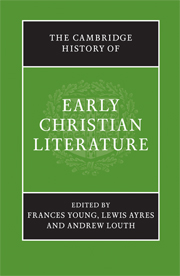Book contents
- Frontmatter
- PART ONE The Beginnings: The New Testament to Irenaeus
- PART TWO THE THIRD CENTURY
- PART THREE FOUNDATION OF A NEW CULTURE: FROM DIOCLETIAN TO CYRIL
- A LITERARY GUIDE
- 21 Classical genres in Christian guise; Christian genres in classical guise
- 22 Arnobius and Lactantius
- 23 Eusebius and the birth of church history
- 24 The fourth-century Alexandrians: Athanasius and Didymus
- 25 Palestine: Cyril of Jerusalem and Epiphanius
- 26 The Cappadocians
- 27 Fourth-century Latin writers: Hilary, Victorinus, Ambrosiaster, Ambrose
- 28 Jerome and Rufinus
- 29 Augustine
- 30 John Chrysostom and the Antiochene School to Theodoret of Cyrrhus
- 31 Cyril of Alexandria
- 32 Hagiography
- 33 Ephrem and the Syriac Tradition
- 34 The literature of the monastic movement
- 35 Women and words: texts by and about women
- 36 Conciliar records and canons
- B CONTEXT AND INTERPRETATION
- Bibliographies
- Index
- Map: The Roman Empire in the late fourth century AD"
- References
35 - Women and words: texts by and about women
from A - LITERARY GUIDE
Published online by Cambridge University Press: 28 March 2008
- Frontmatter
- PART ONE The Beginnings: The New Testament to Irenaeus
- PART TWO THE THIRD CENTURY
- PART THREE FOUNDATION OF A NEW CULTURE: FROM DIOCLETIAN TO CYRIL
- A LITERARY GUIDE
- 21 Classical genres in Christian guise; Christian genres in classical guise
- 22 Arnobius and Lactantius
- 23 Eusebius and the birth of church history
- 24 The fourth-century Alexandrians: Athanasius and Didymus
- 25 Palestine: Cyril of Jerusalem and Epiphanius
- 26 The Cappadocians
- 27 Fourth-century Latin writers: Hilary, Victorinus, Ambrosiaster, Ambrose
- 28 Jerome and Rufinus
- 29 Augustine
- 30 John Chrysostom and the Antiochene School to Theodoret of Cyrrhus
- 31 Cyril of Alexandria
- 32 Hagiography
- 33 Ephrem and the Syriac Tradition
- 34 The literature of the monastic movement
- 35 Women and words: texts by and about women
- 36 Conciliar records and canons
- B CONTEXT AND INTERPRETATION
- Bibliographies
- Index
- Map: The Roman Empire in the late fourth century AD"
- References
Summary
Women’s authorship is rarely found in ancient Christianity. The oldest known artistic work of literature by a Christian woman to survive intact is the Cento Vergilianus de laudibus Christi by a fourth-century noble woman commonly identified as Faltonia Betitia Proba (c. 320–c. 370). Among the very first Christian poems in Latin, Proba’s Cento is some 694 verses in length, retelling Christianity’s sacred history as given in Genesis 1–8 and the New Testament Gospels through one of the most difficult classical literary genres, the cento (from the word for a patchwork cloak; late Gk κéντρων). A cento was a poem consisting solely of lines, half-lines or phrases drawn from earlier, generally epic, works and strung together to present an entirely new subject. Modern scholars have generally scorned the cento, seeing it as a mechanical exercise. But to the ancient eye, the cento in either Greek or Latin was a respected literary form: an artistic challenge of extraordinary difficulty because of its stringent requirements, displaying the highest degree of learning, and paying due reverence to the greatest poetry of the classical era.
Proba constructed her Cento entirely from lines of Virgil. Creation is told through the myth of the Golden Age and Christ is cast as an epic hero in the mould of Aeneas – a stern lawgiver, a valiant bringer of peace. Proba displays a dazzling ingenuity in presenting biblical stories through verses containing no biblical names and expressing an altogether different religious view. Jerome (Ep. 53.7) castigated her efforts to employ Virgil for Christian purposes, indicating by his very complaint the unusual degree to which Proba had succeeded in appropriating classical tradition for Christian use.
- Type
- Chapter
- Information
- The Cambridge History of Early Christian Literature , pp. 382 - 390Publisher: Cambridge University PressPrint publication year: 2004

